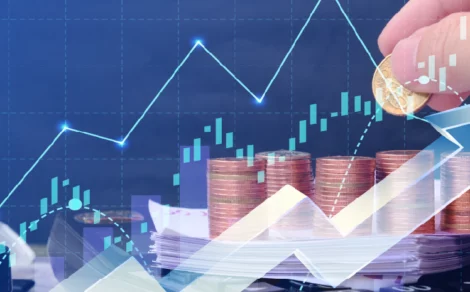This is the time that Wall Street won’t forget anytime soon, with markets plunging, screens turning red, and panic spreading as the US market crashed. The Dow hit a 52-week low, and the S&P 500 neared a bear market, leaving investors wondering if this was the beginning of something major. Unexpected tariffs, geopolitical tensions, and global slowdown fears fueled this sudden stock market sell-off, impacting markets worldwide.
Let’s check out what happened in the US market, why it’s happening, and what it could mean for investors worldwide.
Key Reasons Behind the US Market Crash
Here are the key factors that led to the historic stock market sell-off:
Rising Tensions Between the US and China
The main reason is the rising trade dispute between the United States and China. President Donald Trump imposed high tariffs on Chinese products, and in retaliation, China quickly imposed a 34% tariff on all imports from the US starting on 10 April 2025. This raised concerns about a potential trade war that could impact global supply chains and hinder economic growth.
Worldwide Market Turmoil
Stock markets worldwide experienced significant drops. In Asia, countries such as Japan, Taiwan, and Singapore witnessed substantial losses, up to 10%. This indicates that the panic extended beyond the US, with global investors expressing concerns that further impacted the US market.
Falling Oil Prices and a Weaker Dollar
Oil prices in the US dropped below $60 per barrel, hitting a nearly two-year low. Meanwhile, the US dollar weakened against the Japanese yen, indicating investors’ shift to safer investments amid market instability.
Confusion Over US Fed’s Next Move
The Federal Reserve’s Chairman, Jerome Powell, warned that the trade war could cause higher prices and slower growth, making it challenging for the Fed to lower interest rates. President Trump urged the Fed to cut rates swiftly, creating more uncertainty.
Impact on Major Stock Indices
The US market crash has shaken investor confidence worldwide and impacted the major stock indices.
Dow Jones Industrial Average
The Dow Jones, tracking 30 large US companies, fell by 2,231 points (about 5.5%) in a day. It is the biggest one-day drop since the pandemic. The sharp decline indicates that even stable companies are affected by the global market sell-off.
S&P 500: Nearing Bear Market
The S&P 500, which includes 500 top US companies, fell 6%. If it drops 20% from its peak, it enters a bear market. This means long-term investors expect more pain ahead and slower economic growth. Futures trading now shows the index may soon hit this level, adding to fears of a prolonged downturn.
Nasdaq and Russell 2000
The Nasdaq Composite, consisting mainly of tech stocks, fell by 6%, marking a total decline of over 22% from its recent high, putting it in a bear market. Tech companies, previously leading market gains, are now experiencing significant losses due to trade tensions and lower growth expectations.
The Russell 2000, tracking small-cap US companies, has dropped over 22% from its peak, signalling concerns about the domestic economy. Small businesses often mirror the true state of the economy, and this sharp decline in the index suggests investors are apprehensive about the long-term economic health of the US.
Historical Context: Is This Another 2008 or 2020?
People often compare sudden market crashes to past crises like the 2020 COVID pandemic or the 2008 financial crisis to understand how severe they are. It’s important to analyse historical crashes to better understand the current situation.
Comparing the Current Crash with 2008 and 2020
- 2008 (Global Financial Crisis): This crash was one of the worst in history. It was caused by the collapse of financial institutions and the housing bubble. The S&P 500 lost over 50% of its value. Recovery was slow, taking almost 4 years to reach previous highs.
- 2020 (COVID Crash): In March 2020, global markets crashed due to the COVID-19 pandemic. The S&P 500 dropped by 34% in a month. Governments and central banks responded swiftly with stimulus packages and rate cuts. As a result, the market quickly rebounded. By August 2020, the S&P 500 had returned to pre-COVID levels.
- 2025 (Current Crash): Today’s crash is caused by political and economic tensions, mainly the US-China trade war and concerns about a global recession. The drop has been significant, with over $9 trillion lost in just two days. It’s uncertain how long the downturn will continue or how severe it will be.
How the US Market Crash Impacted India?
Here’s how the US market crash has impacted India:
- Stock Indices Decline: The benchmark indices in India had significant losses. The BSE Sensex fell over 3,900 points, a 5.19% decline. The NSE Nifty also dropped below 22,000.
- Investor Sentiment: Indian markets have dropped sharply in response to the global sell-off. Investors are worried about the trade war and its impact on the global economy.
- Political Reactions: The economic downturn in India has led to political commentary. Congress leader Jairam Ramesh compared US President Donald Trump’s tariffs to Indian economic policies, implying that both leaders harm their economies.
Key Takeaways
The US market crash, caused by the US-China trade war, has led to a global sell-off, impacting Indian markets significantly. This situation is similar to previous crises, but the result will be determined by global policies and investor sentiment. Indian investors should remain calm, stay focused on long-term goals, and avoid panicking in these volatile times.
Stay ahead of market trends—connect with Torus Digital today!


